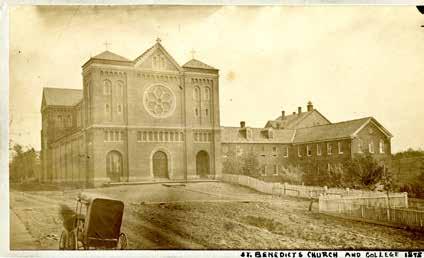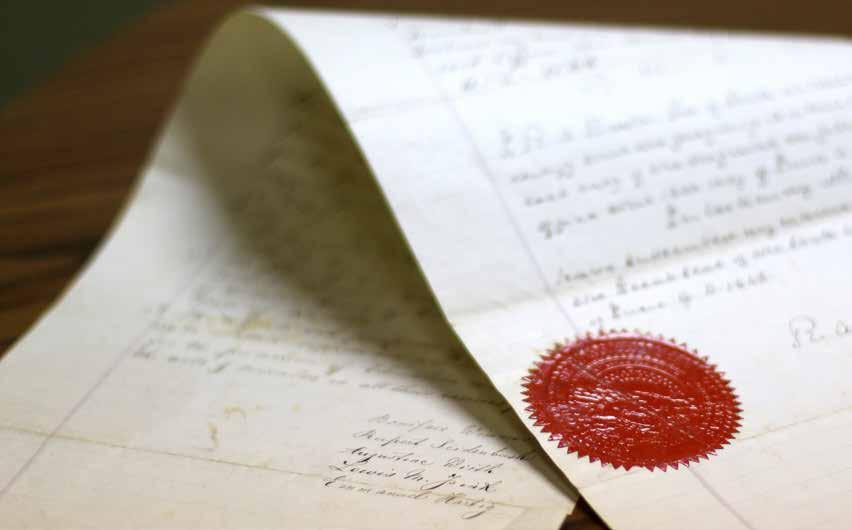
8 minute read
The Foundation
A look at the history of the incorporation of St. Benedict’s Abbey and its apostolates by Fr. Denis Meade
The people who have vowed to serve God
according to the Rule of St. Benedict are the core reality of any Benedictine Community. The monks of St. Benedict’s Abbey count their foundational moment in April 1857, when Prior Augustine Wirth and Fr. Casimir Seitz arrived in Doniphan, Kansas Territory, to join Fr. Henry Lemke. The fledgling American Cassinese Congregation declared the community an autonomous priory in 1858. Wishes do not a reality make since by that time both Fr. Henry and Fr. Casimir had returned to the East. The only member of this paper priory was the Prior, Fr. Augustine Wirth. There was no civil incorporation and as the community took shape its property and other tangible assets were registered as personal belongings of Prior Wirth. Ten years later, in 1868 a change in leadership was effected and simultaneously the community sought incorporation from the state of Kansas. Oddly enough the incorporation was not of the monastery as a religious society but of St. Benedict’s College, an educational institution. No reasons are recorded for the choice of this route.
The incorporators of St. Benedict’s College in 1868 were Abbot Boniface Wimmer, founder of the motherhouse of St. Vincent Abbey, Abbot Rupert Seidenbusch of St. John’s Abbey, Collegeville, Minn., Fr. Louis Mary Fink, the new superior, Fr. Augustine Wirth, the former superior and Fr. Emmanuel Hartig. This charter was expanded upon in 1878, soon after the election of the first abbot, Innocent Wolf, in 1877. Although the community conceived of itself first and foremost as a Roman Catholic Benedictine monastery, it was content to nestle within the College for its civil existence for 63 years. The superior of the community was ipso facto president of the college. Its Board of Directors varied in number but it was composed of the abbot together with the members of his council, customarily called the “Council of Seniors.”
From their earliest days the college and monastery were intertwined. For a model the school looked back to Germany with its classical gymnasium; in America this translated into a curriculum for students from the third grade to the end of junior college. As time went on, specifically academic officials and administrators emerged. Still, it was so closely connected to the monastery that Fr. Peter Beckman in his history Kansas Monks entitled the chapter on the early collegiate years as “Abbot Innocent’s College.” It was not until the mid-twentieth century that significant numbers of lay persons figured in the faculty of the school. Reading the earliest minutes of the monastery chapter, it is not always easy to say whether a meeting was about internal affairs of the community or whether it was a faculty meeting. It would be safe to say that during its first 60 years the school was the community’s “cottage industry” and its students were “family.” It would be unusual to read in a student life handbook of today this admonition of an earlier year to “avoid pulling the ears; it disfigures that organ.”
From its first small lots at Second and Division Streets (shown above, 1898) the community gradually expanded up the hill to the river bluffs and north. The College took on the structures of the standard American liberal arts college and moved the high school division to the south end of Atchison to the campus of Midland College which had moved to Fremont, Neb. The College became fully accredited with the North Central Association of Colleges and Universities. However, by 1931 it was informed that the accreditation was imperiled because of the large debt resulting from the construction of the current monastery. Therefore, on January 29, 1931, the community took the logical and long overdue step of incorporating the Abbey “to establish, support and maintain a religious institution for the promotion of divine worship; for the training of men for the Catholic priesthood and the religious life; and for the holding and conducting of parishes and missions” The debt was transferred to the monastic corporation and the land and buildings distributed between the two institutions.
The rapid evolution of society after World War II and development of educational institutions called for a greater alignment of structures with peer institutions. Fr. Brendan Downey (later abbot) became the first non-abbot president of the College on May 21, 1958. In 1969 the Board of Directors was expanded to include the abbot of St. Benedict’s Abbey as a member and chair, five other monks of the Abbey chosen by its chapter and six nonmembers of the Abbey, lay or clerical. This board had full authority to manage the affairs of the corporation but certain actions required affirmative approval by the governing authority of St. Benedict’s Abbey. Thus while St. Benedict’s College held title to its campus and grounds, sale or leasing of property, merger or consolidation of the College with another institution or dissolution of the same required approval by St. Benedict’s Abbey. It was at this same time that Maur Hill Prep School was removed from the College corporation and was chartered as a separate entity.

As the 1970s began, there was a widespread fear that single sex private colleges could no longer attract viable enrollments. This and other considerations led to an agreement between Mount St. Scholastica College, St. Benedict’s College, Mount St. Scholastica Convent and Saint Benedict’s Abbey to establish a new college to which the parenting colleges would lease their educational properties and a new college, a coeducational institution with two campuses, would provide them with their educational services. There was not a merger, but a lease granted by two colleges which continue to exist to this day. The new college needed a name; a number of proposals were bandied about, among them River Bend College. Keeping it simple, Benedictine College won the day and it was so chartered on April 7, 1971. On August 23, 1971, Benedictine College, created by its two parent colleges and its two sponsoring Benedictine communities, was fully operational.
The Benedictine College Board of Directors is unique inasmuch as it has three types of members: class A and class B directors consist of three members each from St. Benedict’s Abbey and Mount St. Scholastica Monastery. Class C directors are all those who are not members of the two sponsoring communities. Some actions of the board require two-thirds vote of each class of directors. Actions which involve selling or leasing of properties required consent of both of the parent colleges and also of the governing authority of the sponsoring religious communities. This structure was developed precisely to safeguard the heritage and properties developed by the religious communities.
In the late 1980’s when student enrollment began to shrink and finances became strained, Benedictine College, as a cost saving measure, moved all of its use of facilities to the St. Benedict’s College Campus. About 1990, after almost 20 years, the lease agreement between the Mount and Benedictine College concerning the use of the South Campus and buildings was dissolved. The remaining agreements and contracts between the two corporations remained in effect.
About the time that Mount St. Scholastica College and St. Benedict’s College were embarking on the establishment of Benedictine College, many peer Catholic Colleges were either being separately incorporated from their sponsoring religious communities or their boards of governance were being significantly expanded. Given that Benedictine monasteries are local, not regional, entities, insuring of their legitimate interests in what has been built up around them is a primary concern. Very rarely do Benedictine monasteries get up and move to another location. The male Benedictine communities that were reorganizing their colleges approached this challenge from a variety of angles. Currently some abbeys retain the title to all property within which their respective colleges operate. In some cases a third corporation which is composed entirely of members of the sponsoring religious community holds title to all property. In some analogous sense, then, St. Benedict’s College as title holder to its real estate, is providing this guardianship of proprietary interests for St. Benedict’s Abbey.
The Centennial Expansion Program, undertaken in 1944, was the first foray of St. Benedict’s College into the area of development. It was a joint effort of the Abbey and the College. Captained by Mr. Leo Nusbaum, retired businessman of Atchison, its first staff was all monks and Abbot Cuthbert McDonald assumed a leadership role. All funds for both the Abbey and the College were raised by monks under the name of St. Benedict’s College. Its first project was the funding of the construction of St. Martin’s Memorial Hall. The second was the funding of the Abbey Church, designed to serve as both the monastery church and the college chapel. A series of celebratory events inaugurating the Abbey Church in August 1957 was the centerpiece of the centennial celebration of both Abbey and College. In 1969 the Abbey turned over to the College the data of its donor base, and this, together with similar information from Mount St. Scholastica College, formed the foundation of the current donor file of Benedictine College, thus instituting separate advancement efforts by the Abbey and College. Both the Abbey and College maintain their respective development programs for their distinctive needs. Because of this arrangement, a donation to one institution does not benefit the other.
The Abbey rejoices that it has just completed its drive to fund the replacement of its 90-year-old windows. And, we are equally grateful for the great support of our educational apostolates. The community is grateful to all who have helped so generously, both those who are former college or high schools students and all its other friends and benefactors.
A copy of the St. Benedict’s College Charter signed by: Archabbot Boniface Wimmer, Abbot Rupert Seidenbush, Prior Augustine Wirth, Bishop Louis M. Fink, and Fr. Emmanuel Hartig.






